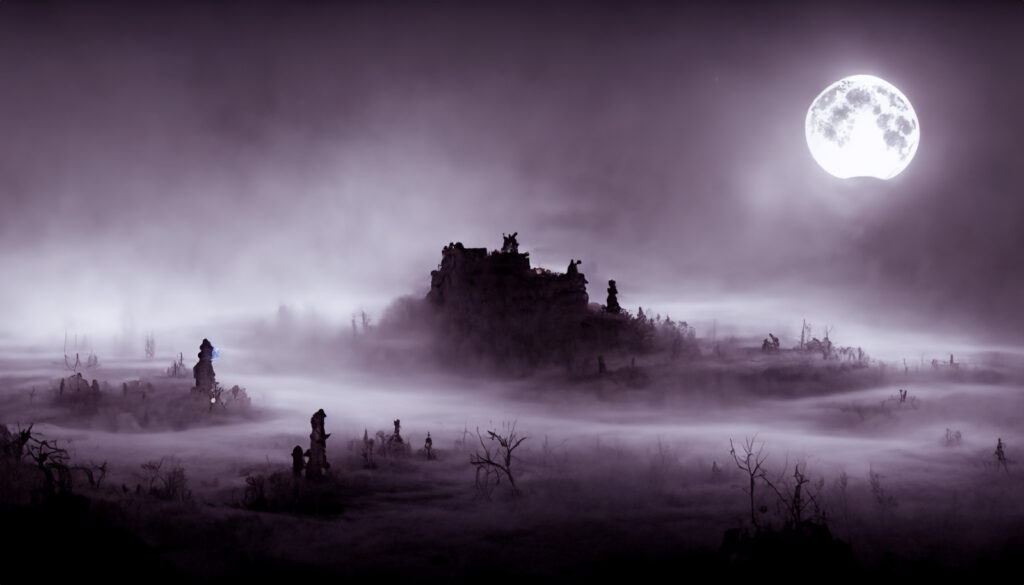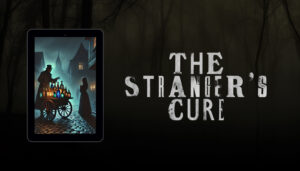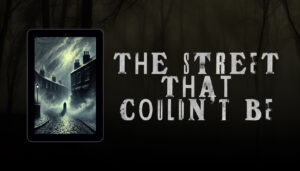Greetings, lovers of the eerie and macabre! Ever found yourself trapped within the chilling tendrils of a horror story, only to find symbols that whisper cryptic messages from beyond the page?
Yeah, same.
Well, prepare yourself. In this article, we’re going to explore how authors use symbolism in their writing, and how they craft tales that stick in your mind long after you’ve turned out the lights.
An Introduction to Symbolism in Dark Fantasy and Horror
In the eerie realms of dark fantasy and horror literature, symbolism serves as a powerful tool wielded by authors to imbue their stories with layers of meaning and evoke visceral reactions in readers.
Symbolism involves the use of images, objects, and motifs to represent abstract concepts, emotions, or themes within a story. These symbols bridge the gap between the tangible and the intangible, and infusing the story with a sense of depth and resonance.
In dark fantasy and horror fictions, symbols take on a life of their own. Authors strategically use symbols to convey deeper truths, foreshadow events, and heighten tension, leaving readers on the edge of their seats.
Let’s explore some of the iconic symbols frequently employed in dark fantasy and horror literature, along with how authors utilise them to enhance their storytelling:
The Ominous Shadow
A ubiquitous symbol in the genre, the ominous shadow represents the unseen forces of darkness lurking just beyond the veil of perception.
Authors often use shadows to evoke feelings of dread and uncertainty, hinting at the presence of malevolent entities or hidden dangers waiting to be revealed.
The Macabre Reflection
Mirrors and reflective surfaces serve as potent symbols of introspection and self-discovery in dark fantasy and horror literature.
Authors use mirrors to explore themes of identity, duality, and the blurred line between reality and illusion. The distorted reflections staring back at characters mirror their inner turmoil and psychological descent into madness.
The Haunting Silence
Silence, while seemingly innocuous, holds immense power as a symbol in dark fantasy and horror literature.
Who doesn’t love a good silence? Authors definitely do. Used more in film and television, silence creates moments of tension and anticipation, heightening the atmosphere of dread and unease. Think about The Quiet Place (1 and 2).
The absence of sound becomes a palpable presence, signalling impending danger or supernatural phenomena lurking just beyond the edge of perception.
The Forbidden Fruit
A timeless symbol of temptation and forbidden knowledge, the forbidden fruit represents the allure of the unknown and the consequences of indulging in forbidden desires.
Authors often use this symbol to explore themes of morality, hubris, and chasing forbidden truths, leading characters down a path of self-destruction and damnation.
Iconic Symbols in Dark Fantasy and Horror
In the shadowy landscapes of dark fantasy and horror literature, certain symbols emerge repeatedly, leaving an indelible mark on the reader’s psyche.
Steeped in rich tradition and folklore, some symbols serve as potent catalysts for evoking powerful emotions in the reader. Let’s explore some of these enduring symbols and the profound impact they have on the genre.
The Labyrinthine Maze
Symbolising the labyrinth of the human mind or the perilous journey through the unknown, mazes and labyrinthine structures feature prominently in dark fantasy and horror literature.
Mazes reflect the character’s psychological torment or existential dread. They also show the relentless pursuit of truth or salvation. The twisting passages of the maze mirror the complexities of the human psyche, leading characters deeper into the abyss of their own fears and desires.
The Key
Keys hold a special significance in dark fantasy and horror literature, representing access to forbidden knowledge, hidden realms, or locked-away secrets.
Keys are symbols of revelation and transformation. They unlock doors to otherworldly dimensions or the mysteries of the human soul. The journey to get the key becomes a quest for enlightenment or a descent into madness, as characters grapple with the consequences of what lies beyond the threshold.
The Fog
Fog, mist, and other atmospheric events frequently shroud the landscapes of dark fantasy and horror literature. Think about it, you can’t see further than your hand. What’s your first thought? Who else is out there? What’s following me? Where did that sound come from? Exactly.
By obscuring vision and distorting reality, authors use fog to create an atmosphere of uncertainty and disorientation, blurring the boundaries between the seen and the unseen.
Within the swirling mists, hidden terrors lurk, waiting to ensnare unwary travellers and plunge them into the depths of their worst nightmares.
The Thicket
Dense forests, tangled undergrowth, and foreboding woods represent humanity’s primal fear of the unknown. Authors use these natural landscapes to evoke feelings of isolation, vulnerability, and the primal instinct for survival.
Characters navigating the labyrinthine depths of the forest confront their innermost fears and darkest desires, confronting the savage forces that dwell within.
Interpreting Symbolism in Horror and Dark Fantasy
As readers journey through the twisted corridors of horror and dark fantasy literature, they encounter a myriad of symbols lurking beneath the surface, each whispering secrets and hidden truths.
But how can you decipher the language of symbolism and unravel its meanings? Well, I got you.
At the heart of interpreting symbolism lies the recognition that symbols operate on multiple levels of meaning simultaneously.
On the surface, a symbol may represent a tangible object or concept within the story. But beneath this literal interpretation lies a deeper, more symbolic significance. Authors embed symbols within their narratives to convey abstract ideas, evoke emotional responses, and enrich the thematic resonance of their stories.
Understanding Context
Understanding symbolism hinges upon an knowing the context in which the symbol appears. Symbols take on different meanings depending on their cultural, historical, and narrative context.
For example, a crucifix may symbolise religious devotion in one story but represent supernatural protection or defiance against evil in another.
By considering the broader context of the narrative, readers can discern the intended meaning behind the symbols employed by the author.
Analysing Patterns and Motifs
In horror and dark fantasy literature, authors often write repeated patterns and motifs to reinforce thematic elements and narrative motifs.
Whether it’s the repeated appearance of a particular animal, colour, or object, recognising patterns allows readers to discern the underlying themes and symbolism woven into the fabric of the narrative.
Exploring Subtext and Symbolic Associations
Symbols often operate on a subconscious level, evoking emotional responses and associations that transcend rational understanding.
Readers can interpret symbolism by exploring the sub-textual associations and emotional resonance evoked by the symbol within the narrative.
By tapping into their own personal experiences, cultural background, and psychological archetypes, readers can uncover the deeper layers of meaning embedded within the symbolism of the story.
Examples from popular media
Now that we’ve explored the art of interpreting symbolism in horror and dark fantasy literature, let’s turn our attention to some examples from popular media that showcase the power of symbolism in action.
These iconic works of fiction show how authors and creators use symbolism to enrich their storytelling and evoke powerful emotional responses in audiences:
Film: “Pan’s Labyrinth” (2006)
Guillermo del Toro’s dark fantasy masterpiece “Pan’s Labyrinth” is a treasure trove of symbolism, weaving together themes of innocence, sacrifice, and the power of imagination.
The Faun, a mysterious creature who guides the protagonist, symbolises the ambiguous nature of morality and the blurred line between good and evil. The Pale Man, with his eyes in the palms of his hands, represents the corrupting influence of greed and the consequences of succumbing to temptation.
Literature: “The Shining” by Stephen King
In Stephen King’s horror classic “The Shining,” the Overlook Hotel serves as a potent symbol of isolation, madness, and the haunted past that haunts its inhabitants.
The hedge animals, brought to life by supernatural forces, show the protagonist’s descent into madness and the sinister forces that lurk within the hotel’s walls. Through these symbols, King creates a chilling atmosphere of psychological horror and existential dread.
Television: “Twin Peaks” (1990-1991)
David Lynch’s surreal mystery series “Twin Peaks” is renowned for its rich symbolism and dreamlike imagery.
The Red Room, with its chevron-patterned floor and mysterious inhabitants, highlights the subconscious mind, along with the hidden truths lurking beneath the surface of reality. The owls, often depicted as silent observers, represent the mysterious and unknowable forces that govern the town of Twin Peaks.
Video Games: “Silent Hill 2” (2001)
Konami’s psychological horror game “Silent Hill 2” is a masterclass in atmospheric storytelling and symbolic imagery.
The town of Silent Hill itself serves as a symbol of the protagonist’s guilt and repressed memories, manifesting as a nightmarish landscape of twisted streets and fog-shrouded alleys.
The iconic Pyramid Head, a towering figure clad in a blood-stained apron, symbolises the protagonist’s inner demons and the torment of his own psyche.
In summary
Well, there you have it. I hope you found that article useful. From the untapped depths of the human psyche to the eerie landscapes of the supernatural, symbols serve as gateways to deeper truths and hidden meanings.
By delving into the art of interpreting symbolism, readers like you can gain valuable insights into how authors craft tales that resonate with our deepest fears, desires, and emotions.
Armed with this newfound understanding, it’s time to go unlock the mysteries that lie in wait in your favourite stories.
See you soon.



